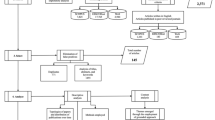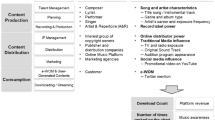Abstract
This chapter examines the artist direct segment, namely independent artists self-releasing music into the global marketplace, without the financial support of record label funding. The chapter begins by defining the artist direct segment within the independent sector of the digital music industries. Second, the chapter considers key indicators that suggest an independent artist may be market ready. The premise is that artists that fulfil some or all of these market readiness indicators are more likely to build a sustainable independent career and/or attract the interest of music business intermediaries who may view these indicators as reducing risk in a competitive marketplace. The methodology consisted of twelve in-depth interviews. Participants represented a cross-section of music business professionals to validate and evolve the framework. Key findings include that the song is a central component of market readiness; that a unique brand identity and its extension in social media are important; and that a social media presence is more valuable than an artist’s website in terms of discovery and using social analytics to guide commercial decision making. The outcomes provide career development opportunities for independent artists and are useful for educators to identify appropriate areas of skills development in music industry–related programs.
Access this chapter
Tax calculation will be finalised at checkout
Purchases are for personal use only
Similar content being viewed by others
References
Allen, P., Hutchison, T., Macy, A., & Rolston, C. (2016). Record label marketing (3rd ed.). Focal Press.
Anderson, C. (2004). The long tail. Wired Magazine, 12, 170–177.
Anderson, L. (2006). Analytic autoethnography. Journal of Contemporary Ethnography, 35(4), 373–395.
Anderton, C., Dubber, A., & James, M. (2012). Understanding the music industries. Sage.
Arnould, E. J., & Price, L. L. (1993). River magic: Extraordinary experience and the extended service encounter. Journal of Consumer Research, 20(1), 24–45.
Baym, N., Bergmann, R., Bhargava, R., Diaz, F., Gillespie, T., Hesmondhalgh, D., & Persaud, C. J. (2021). Making sense of metrics in the music industries. International Journal of Communication, 15, 3418–3441.
Baym, N. K. (2013). Fans or friends?: Seeing social media audiences as musicians do. Matrizes, 7(1), 13–46.
Bruner, R. (2021, March 30). The livestream show will go on. How COVID has changed live music–Forever. Timehttps://time.com/5950135/livestream-music-future/
Caves, R. (2000). Creative industries: Contracts between art and commerce. Harvard University Press.
CDBaby. (2021). DIY musician. CDBaby. https://diymusician.cdbaby.com/
Crosby, P., & McKenzie, J. (2021). Survey evidence on the impact of COVID-19 on Australian musicians and implications for policy. International Journal of Cultural Policy. Advance online publication. doi:https://doi.org/10.1080/10286632.2021.1916004.
Eisenhardt, K. M. (1989). Building theories from case study research. Academy of Management Review, 14(4), 532–550.
Elberse, A. (2008). Should you invest in the long tail? Harvard Business Review, 86(7/8), 88.
Eliezer, C. (2020, March 25). Will livestreaming become the new business model for venues in the post coronavirus landscape? The industry observer. https://theindustryobserver.thebrag.com/will-livestreaming-become-the-new-business-model-for-venues/
Ellis, C., Adams, T. E., & Bochner, A. P. (2011). Autoethnography: An overview. Forum Qualitative Sozialforschung/Forum: Qualitative Social Research, 12(1), art. 10.
Hughes, D., Keith, S., Morrow, G., Evans, M., & Crowdy, D. (2013). What constitutes artist success in the Australian music industries? International Journal of Music Business Research (IJMBR), 2(2), 60–80.
Galuszka, P., & Wyrzykowska, K. M. (2019). Rethinking independence: What does ‘independent record label’ mean today? In E. Mazierska, L. Gillon, & T. Rigg (Eds.), Popular music in the post-digital age: Politics, economy, culture and technology (pp. 33–50). Bloomsbury Academic.
Gilks, P. (2016). Constructing authentic identities: Why narratives are better than chronicles of achievement in musicians’ biographies. International Journal of Music Business Research, 5(2), 26–45.
Hall, S. (2020, May 27). This is how COVID-19 is affecting the music industry. World economic forum. https://www.weforum.org/agenda/2020/05/this-is-how-covid-19-is-affecting-the-music-industry/
Handke, C. (2020). Music industry handbook of cultural economics (3rd ed.). Edward Elgar.
Herstand, A. (2020). How to make it in the new music business: Practical tips on building a loyal following and making a living as a musician (2nd ed.). Liveright.
Hracs, B. J. (2012). A creative industry in transition: The rise of digitally driven independent music production. Growth and Change, 43(13), 442–461.
Hubbert, A. R., Sehorn, A. G., & Brown, S. W. (1995). Service expectations: The consumer versus the provider. International Journal of Service Industry Management, 6(1), 6–21.
Hughes, D., Evans, M., Morrow, G., & Keith, S. (2016). The new music industries: Disruption and discovery. Springer.
Hyatt, A. (2021). Cyber PR. https://www.cyberprmusic.com/
IFPI. (2021). IFPI global music report 2021. IFPI. https://www.ifpi.org/
Indepreneur. (2021). Full stack creative. https://www.youtube.com/c/Indepreneur
Khodaei, H., Scholten, V., Wubben, E., & Omta, O. (2021). Bridging the gap between entrepreneurial orientation and market opportunity: The mediating effect of absorptive capacity and market readiness. In A. C. Corbett, P. M. Kreiser, L. D. Marino, & W. J. Wales (Eds.), Entrepreneurial orientation: Epistemological, theoretical, and empirical perspectives (pp. 201–222). Emerald.
Lewis, G. J., Graham, G., & Hardaker, G. (2005). Evaluating the impact of the internet on barriers to entry in the music industry. Supply Chain Management: An International Journal, 10(5), 349–356.
McHenry, L. (2021). The savvy musician show. Savvy musician academy. https://savvymusicianacademy.com/podcast/
Meier, L. M. (2017). Popular music as promotion: Music and branding in the digital age. John Wiley & Sons.
Midia. (2020). The changing nature of music creation. Midia Research https://www.musicbusinessworldwide.com/files/2020/03/MIDiA-Consulting-AMUSE.pdf
Miles, M. B., & Huberman, A. M. (1994). Qualitative data analysis: An expanded sourcebook. Sage.
Miller, L. (2019). Same heart. New beat: How record labels amplify talent in the modern music marketplace. Musonomics. http://musonomics.org/new-report-illustrates-how-modern-record-labels-remade-themselves-in-the-streaming-era/
Mizzau, L. (2020). Digital music (r)evolution: Disruption through digital transformation in the music industry. In M. Massi, M. Vecco, & Y. Lin (Eds.), Digital transformation in the cultural and creative industries: Production, consumption and entrepreneurship in the digital and sharing economy (pp. 119–139). Routledge.
Morrow, G. (2018). Artist management: Agility in the creative and cultural industries. Routledge.
Morrow, G. (2020). Designing the music business: Design culture, music video and virtual reality. Springer.
Mulligan, M. (2020). Welcome to the age of the artist. Music industry blog. https://musicindustryblog.wordpress.com/2020/02/27/welcome-to-the-age-of-the-artist/
Mulligan, M. (2021). Smaller independents and artists direct grew fastest in 2020. MIDiA blog. https://www.midiaresearch.com/blog/smaller-independents-and-artists-direct-grew-fastest-in-2020.
Murphy, S. (2020). Music marketing in the digital music industries–An autoethnographic exploration of opportunities and challenges for independent musicians. International Journal of Music Business Research, 9(1), 6–44.
Nordgård, D. (2016). Lessons from the world’s most advanced market for music streaming services. In P. Wikström & R. DeFillippi (Eds.), Business innovation and disruption in the music industry (pp. 175–190). Edward Elgar.
Oszajca, J. (2021). Music marketing manifesto. https://www.musicmarketingmanifesto.com/podcast
Pedersen, R. R. (2018). Exploring bounty and spread: Key changes in the Danish music streaming economy. International Journal of Music Business Research, 7(1), 6–25.
Peter, M. K., & Dalla Vecchia, M. (2021). The digital marketing toolkit: A literature review for the identification of digital marketing channels and platforms. In R. Dornberger (Ed.), New trends in business information systems and technology: Digital innovation and digital business transformation (pp. 251–265). Springer.
Pettine, K. (2021). Streaming & screaming: Intellectual property rights’ survival in a 21st century music industry (San Diego legal studies paper No. 21-005). University of San Diego.
Porter, M. E. (1979). How competitive forces shape strategy. Harvard Business Review, 57(2), 137–145.
Prey, R., Esteve Del Valle, M., & Zwerwer, L. (2022). Platform pop: Disentangling Spotify’s intermediary role in the music industry. Information, Communication & Society, 25(1), 74–92.
PwC. (2021). COVID-19: Music is the answer for many, but what’s the impact on the industry? PwC. https://www.pwc.co.uk/issues/crisis-and-resilience/covid-19/covid-19-impact-on-the-music-industry.html
Qualtrics. (2021). Market readiness. Qualtrics. https://www.qualtrics.com/au/market-research/market-readiness/
RaineGroup. (2020). The independent artist sector: Defining and sizing the music industry’s fastest-growing sector. RaineGroup. https://www.musicbusinessworldwide.com/files/2020/03/The-Independent-Artist-2020.03.14-vEXTERNAL.pdf
Simpson, S. (2006). Music business: A musician’s guide to the Australian music industry by top Australian lawyers and deal makers (3rd ed.). Omnibus Press.
Spurgeon, C. (2007). Advertising and new media. Routledge.
Stewart, S. (2018). The development of the artist–fan engagement model. International Journal of Music Business Research, 7(2), 52–82.
Sun, H. (2019). Digital revolution tamed: The case of the recording industry. Springer.
Szymkowiak, A., Kubala, B. M., & Antoniak, M. A. (2020). Music sales and artists popularity on social media. International Journal of Marketing, Communication and New Media, 8(14), 70–96.
Throsby, D., & Petetskaya, K. (2017). Making art work: An economic study of professional artists in Australia. Australia Council for the Arts. https://australiacouncil.gov.au/advocacy-and-research/making-art-work/
Tschmuck, P. (2017). The economics of music. Agenda.
Von Hippel, E. (1989). New product ideas from ‘lead users’. Research-Technology Management, 32(3), 24–27.
Walzer, D. A. (2017). Independent music production: How individuality, technology and creative entrepreneurship influence contemporary music industry practices. Creative Industries Journal, 10(1), 21–39.
Wikström, P. (2020). The music industry: Music in the cloud. John Wiley & Sons.
Williamson, J., & Cloonan, M. (2007). Rethinking the music industry. Popular Music, 26(2), 305–322.
WIN. (2019). Wintel worldwide independent market report 2018. Worldwide independent network. http://winformusic.org/market-reports/wintel2018/
Author information
Authors and Affiliations
Corresponding author
Editor information
Editors and Affiliations
Appendix: Research Participants
Appendix: Research Participants
Participant No. | Acronym | Job title | Date of interview |
|---|---|---|---|
1 | BA | Booking agent (major festivals, tours) | 31 May 2021 |
2 | IL | A + R manager, independent record label | 2 June 2021 |
3 | MP | Music producer/independent record label head | 3 June 2021 |
4 | IMD | Independent radio music director | 7 June 2021 |
5 | IA | Independent artist (full-time) | 11 June 2021 |
6 | AM | Artist manager (platinum level) | 12 June 2021 |
7 | ME | Music business educator/producer | 4 Aug 2021 |
8 | CMD | Commercial radio music director | 5 Aug 2021 |
9 | ML | A + R manager, major record label | 13 Aug 2021 |
10 | MP | CEO, major publishing company | 7 Sept 2021 |
11 | MM | Music media owner (print-online) | 8 Sept 2021 |
12 | SS | Artist & label partnership lead, streaming service | 9 Sept 2021 |
Rights and permissions
Copyright information
© 2022 The Author(s), under exclusive license to Springer Nature Switzerland AG
About this chapter
Cite this chapter
Murphy, S., Hume, M. (2022). Market Readiness for the Digital Music Industries: A Case Study of Independent Artists. In: Morrow, G., Nordgård, D., Tschmuck, P. (eds) Rethinking the Music Business. Music Business Research. Springer, Cham. https://doi.org/10.1007/978-3-031-09532-0_12
Download citation
DOI: https://doi.org/10.1007/978-3-031-09532-0_12
Published:
Publisher Name: Springer, Cham
Print ISBN: 978-3-031-09531-3
Online ISBN: 978-3-031-09532-0
eBook Packages: Literature, Cultural and Media StudiesLiterature, Cultural and Media Studies (R0)




